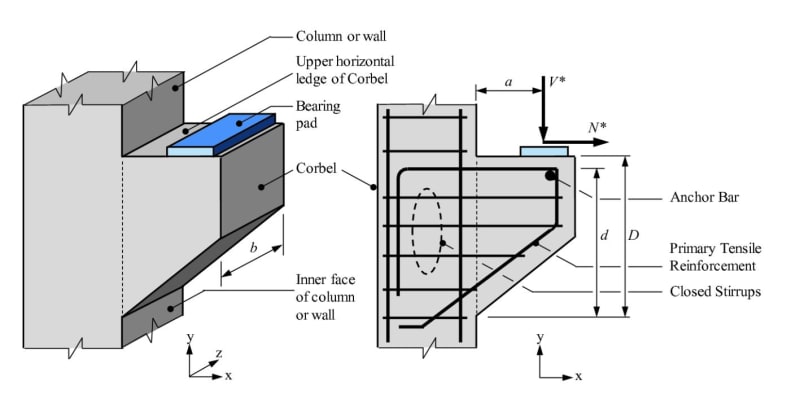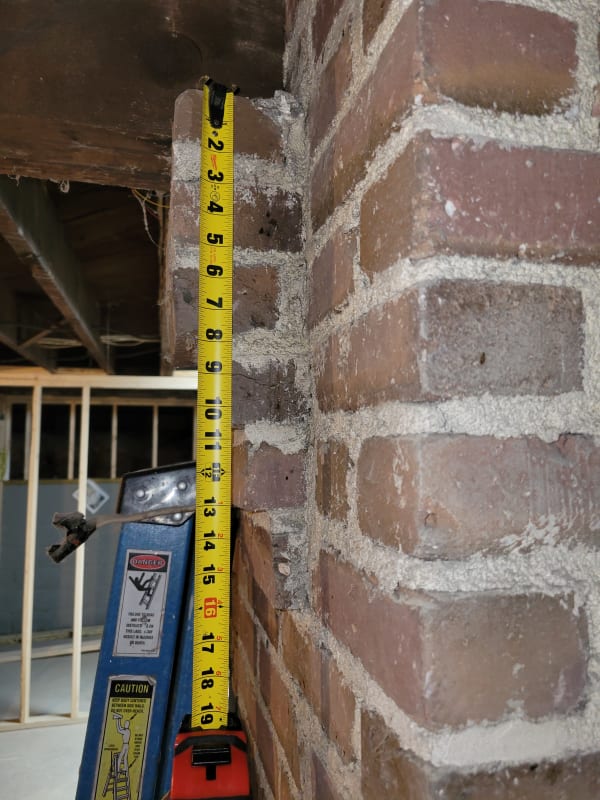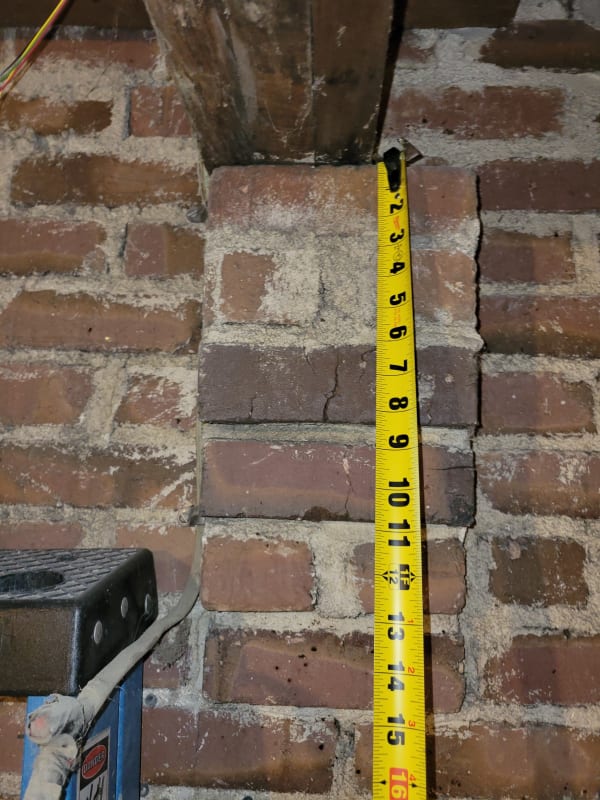I have a client that is wanting to remove the center beam support in the now finished basement. I have sized the replacement beam and looked at the new end bearing loads which are roughly 3x what they were. The existing bearing pressure is 150 psi and the new conditions push that upwards to 375 psi. From what references I have been able to find, the corbel is constructed as it should be. Are there any references on calculating the load carrying capacity of a corbel?
Navigation
Install the app
How to install the app on iOS
Follow along with the video below to see how to install our site as a web app on your home screen.
Note: This feature may not be available in some browsers.
More options
Style variation
-
Congratulations TugboatEng on being selected by the Eng-Tips community for having the most helpful posts in the forums last week. Way to Go!
You are using an out of date browser. It may not display this or other websites correctly.
You should upgrade or use an alternative browser.
You should upgrade or use an alternative browser.
Load carrying capacity of a brick corbel 1
- Thread starter shane
- Start date
- Status
- Not open for further replies.
When you talk about a corbel, I think of something like you see below. It is reinforced concrete and it is designed to carry an eccentric load which causes a moment in the wall or column to which the corbel is attached.
That doesn't tell us much. I very much doubt that an existing brick corbel will be adequate to sustain a load 2.5 times the load it carried previously. I wonder whether your new beam can be supported directly on the wall (without a corbel) and whether the existing foundation is adequate for the larger load.

shane said:From what references I have been able to find, the corbel is constructed as it should be.
That doesn't tell us much. I very much doubt that an existing brick corbel will be adequate to sustain a load 2.5 times the load it carried previously. I wonder whether your new beam can be supported directly on the wall (without a corbel) and whether the existing foundation is adequate for the larger load.

- Thread starter
- #3
Thanks BAretired,
Understood. This one is constructed with masonry and is in an early 1920s house supporting a girder off one side of a chimney.
I found this reference both online and in an older thread and it discusses the proper way to construct a brick corbel which is where my comment about it being "properly" constructed came from.
Link
The linked refence seems to indicate the stress is transferred back into the bearing structure in the load distribution details but I want some more verification if that is the case. I don't see any signs of reinforcing and the mortar appears intact.
Here are 2 pictures of the corbel.


I am planning on requiring additional support in the form of shear bolts or an additional column but I was curious if there was a load calculation somewhere.
The current loading conditions are coming up with ~2.8k lbs (live and dead loads) with the modified condition being closer to 10k.
Understood. This one is constructed with masonry and is in an early 1920s house supporting a girder off one side of a chimney.
I found this reference both online and in an older thread and it discusses the proper way to construct a brick corbel which is where my comment about it being "properly" constructed came from.
Link
The linked refence seems to indicate the stress is transferred back into the bearing structure in the load distribution details but I want some more verification if that is the case. I don't see any signs of reinforcing and the mortar appears intact.
Here are 2 pictures of the corbel.


I am planning on requiring additional support in the form of shear bolts or an additional column but I was curious if there was a load calculation somewhere.
The current loading conditions are coming up with ~2.8k lbs (live and dead loads) with the modified condition being closer to 10k.
The strength of corbel is not the only issue to be resolved. You have a load of 10,000# acting at an eccentricity of at least 6" from the center of the wall (I am assuming it is a double wythe with a total thickness of 8"). It is probably more like a 7" eccentricity because the beam rotates and bears more heavily on the inside face of the corbel. The moment applied to the top of wall is approximately 70,000 inch-lbs which creates significant tensile stress in the wall, possibly an unrealistic expectation for hundred year old brick and mortar.
The foundation is likely a non-reinforced strip footing of unknown width, and we have no idea what bearing pressure the soil can sustain. If you are expecting the wall to act as a deep beam to spread the load over a larger length of footing, the wall would be subjected to bending stress.
An additional column could be a good idea, but it may require underpinning if the existing foundation is not adequate or does not extend far enough to accommodate the column base plate.
The foundation is likely a non-reinforced strip footing of unknown width, and we have no idea what bearing pressure the soil can sustain. If you are expecting the wall to act as a deep beam to spread the load over a larger length of footing, the wall would be subjected to bending stress.
An additional column could be a good idea, but it may require underpinning if the existing foundation is not adequate or does not extend far enough to accommodate the column base plate.
bigester93 said:corbel shall no be checked as beam
bigester93,
Your latest comment is, as usual, laconic, irrelevant and uninformative.
shane,
You write "bearing pressure" so I assume you are not meaning shear stress. With 10,000 lbs it looks like you'll have over 200 psi shear on the corbel (in best case scenario) so I'd def add something to carry that load. I'd think some sort of cleat or steel bracket underneath the existing corbel would be the approach I'd start with (sounds like you might be thinking that also). Whether you put one steel element underneath the corbel or two on the sides with an angle or bearing plate under the new beam might depend on how mane anchors you need to support the load. I'd look at getting all of the load into whatever bracket you add due to possible difference in stiffnesses between the corbel and the steel bracket attachment.
If they could stand to lose a little floorspace, you could just add a column and footing next to the existing chimney (as close as possible). That might keep things pretty simple.
BA, the masonry component is a chimney and not a wall so.... eccentricity MIGHT not be such a big deal since I expect the chimney has lots of dead load. The 10,000 probably involves a lot of live load which does not often materialize in a single family residential situation. Still it's something to check on...
You write "bearing pressure" so I assume you are not meaning shear stress. With 10,000 lbs it looks like you'll have over 200 psi shear on the corbel (in best case scenario) so I'd def add something to carry that load. I'd think some sort of cleat or steel bracket underneath the existing corbel would be the approach I'd start with (sounds like you might be thinking that also). Whether you put one steel element underneath the corbel or two on the sides with an angle or bearing plate under the new beam might depend on how mane anchors you need to support the load. I'd look at getting all of the load into whatever bracket you add due to possible difference in stiffnesses between the corbel and the steel bracket attachment.
If they could stand to lose a little floorspace, you could just add a column and footing next to the existing chimney (as close as possible). That might keep things pretty simple.
BA, the masonry component is a chimney and not a wall so.... eccentricity MIGHT not be such a big deal since I expect the chimney has lots of dead load. The 10,000 probably involves a lot of live load which does not often materialize in a single family residential situation. Still it's something to check on...
-
1
- #8
I may lose business with my approach to this, but I'd be telling the owner that we're using a new column and footing for this end of the new beam. You can probably put it 12-18" from the chimney and not deal with whether the existing brick can carry triple the load.
Often in a situation like this all the information you need to properly calculate the capacity of this corbel is unknown. f'm of the brick? type of mortar? footing under the chimney? capacity of the soil? In my experience: unknown unknown unknown unknown. You can make a good guess at these things, of course, but I take into consideration the type of failure that would occur if I'm wrong.
Often in a situation like this all the information you need to properly calculate the capacity of this corbel is unknown. f'm of the brick? type of mortar? footing under the chimney? capacity of the soil? In my experience: unknown unknown unknown unknown. You can make a good guess at these things, of course, but I take into consideration the type of failure that would occur if I'm wrong.
jerseyshore
Structural
I'm with you kipfoot, this isn't even something I would bother trying to analyze. Too much risk vs reward on this one.
I think it's a shame that this sort of knowledge has been lost. I tend to agree that this is a 'who-knows?' situation with regard to its capacity. It's just not worth the effort of digging up old references or setting up a FE model to check something like this.
But there are many unreinforced masonry structures like this, some dating back thousands of years, which are still standing today. They use brackets and corbels (similar to the OP), but also arches, vaulted ceilings, etc., all to great visual effect and efficient structural use of materials.
Obviously the OP's example isn't anything worth a second look at. But would anyone alive today have the technical know-how to design and build a Notre Dame Cathedral or similar structure?
But there are many unreinforced masonry structures like this, some dating back thousands of years, which are still standing today. They use brackets and corbels (similar to the OP), but also arches, vaulted ceilings, etc., all to great visual effect and efficient structural use of materials.
Obviously the OP's example isn't anything worth a second look at. But would anyone alive today have the technical know-how to design and build a Notre Dame Cathedral or similar structure?
bugbus said:But would anyone alive today have the technical know-how to design and build a Notre Dame Cathedral or similar structure?
Absolutely. One of my main practice areas is historical structures. I love them! Especially this sort of thing. I've met some absolutely brilliant people in this space. And yes, they can (and are) capable of reconstructing Notre-Dame de Paris.
BUT...it's a question of economics. Yes, lots of these buildings are standing. But lots that used them are NOT standing, too. I'd wager a higher percentage that used them are no longer standing than are. So it's a question of reliability. It is an inherently less reliable design with a brittle failure mode. So we've chosen not to use it anymore. There has also been something of a culture shift in the 'value' of a building over the last few generations, and we have tended toward cheaper and more disposable construction methods. That's not all bad. Can you imagine how much a house would cost today if it were built with three wythes of hand pressed and fired brick with mortar mixed from sand you hope you can find when you excavate the foundation? Bringing in a few trucks of lumber and OSB is way more affordable (ish).
jerseyshore
Structural
Yupp, that's the core of survivorship bias. We see buildings like the Pantheon still standing, but not the thousand of other unreinforced domes that didn't survive.
I love this forum because even though I would never analyze 95% of what is posted on here, it's awesome to follow along and reassuring to know there are a lot of people out there that do. For most of the work that I do, the additional design & construction costs, combined with the liability to do "hard" or "weird" or "unconventional" designs just don't make it worth it economically. But when you're like OP and want to tackle something like this, there's still plenty of knowledge around here to help.
I love this forum because even though I would never analyze 95% of what is posted on here, it's awesome to follow along and reassuring to know there are a lot of people out there that do. For most of the work that I do, the additional design & construction costs, combined with the liability to do "hard" or "weird" or "unconventional" designs just don't make it worth it economically. But when you're like OP and want to tackle something like this, there's still plenty of knowledge around here to help.
jerseyshore said:We see buildings like the Pantheon still standing
They just don't build 'em like they used to...
Regarding this specific corbel, based on the Australian Masonry standard AS3700, it would appear to fail.
Ultimate load is 10,000 which is 45 kN
You would need a shear area of 45000/0.72MPa = 62500 mm2 to satisfy just the shearing force through the vertical plane. You appear to have less area than that crossing the shear plane (mortar doesn't count, only bricks crossing the plane).
You also have some moment on the corbel, which adds tension to the bricks, making things worse.
Ultimate load is 10,000 which is 45 kN
You would need a shear area of 45000/0.72MPa = 62500 mm2 to satisfy just the shearing force through the vertical plane. You appear to have less area than that crossing the shear plane (mortar doesn't count, only bricks crossing the plane).
You also have some moment on the corbel, which adds tension to the bricks, making things worse.
- Status
- Not open for further replies.
Similar threads
- Replies
- 1
- Views
- 8K
- Locked
- Question
- Replies
- 23
- Views
- 5K
- Replies
- 3
- Views
- 2K
- Replies
- 6
- Views
- 5K
- Replies
- 2
- Views
- 2K
